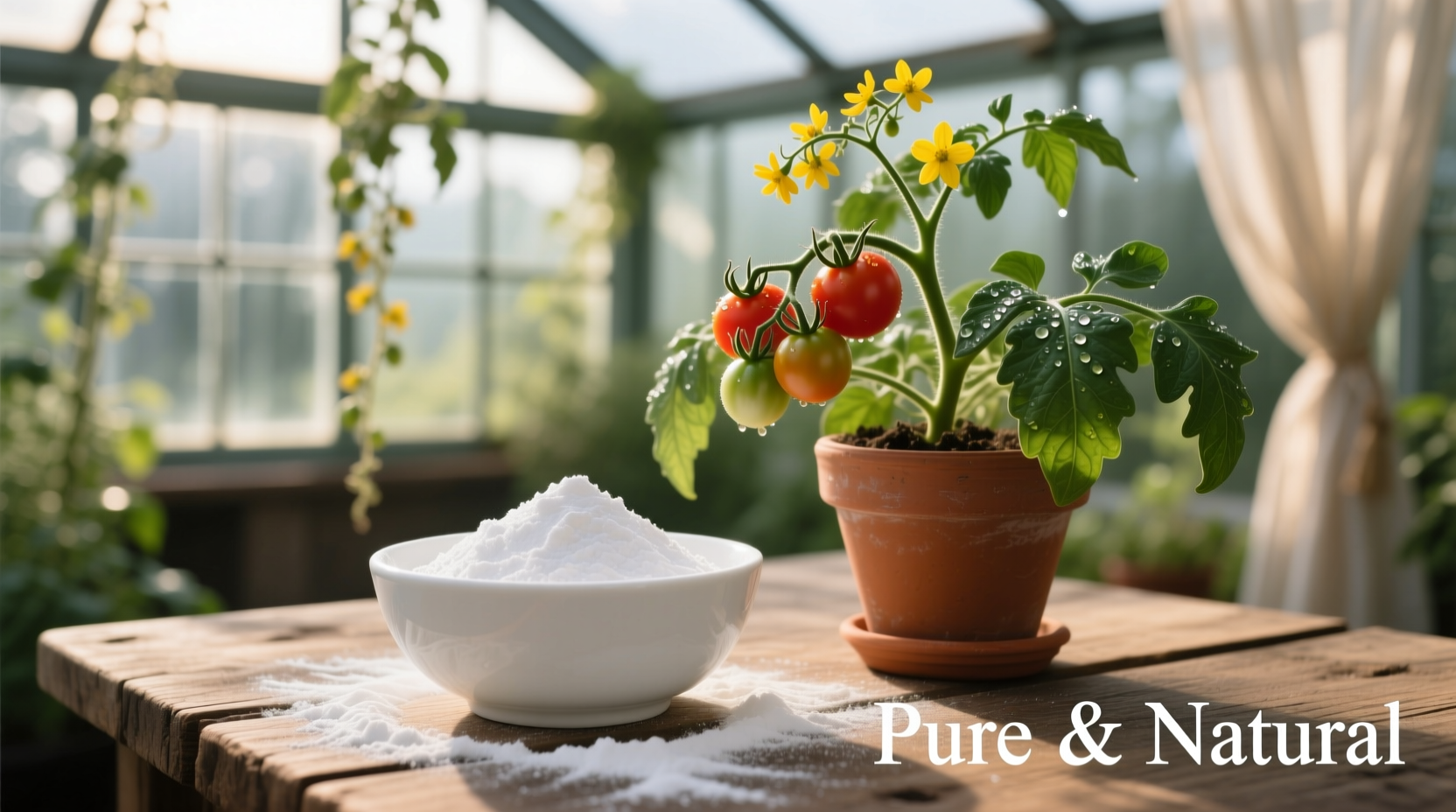Why Gardeners Turn to Baking Soda for Tomato Plants
Tomato growers constantly battle fungal diseases that can devastate their crops. When you notice the first yellow spots on lower leaves or that telltale white powdery coating, you need solutions fast. Many home gardeners prefer organic approaches over chemical fungicides, which is why baking soda has gained popularity as a natural treatment option. Research from University of Minnesota Extension confirms that sodium bicarbonate creates an alkaline surface that inhibits fungal spore germination, making it a valuable tool in your organic gardening arsenal.
What Science Says About Baking Soda and Tomato Plants
Sodium bicarbonate (baking soda) works by raising the pH on plant leaves, creating an environment where fungal spores struggle to germinate. According to studies published by American Society for Horticultural Science, baking soda solutions show moderate effectiveness against powdery mildew when applied preventatively. However, it's crucial to understand that baking soda is not a cure-all solution and has specific limitations based on environmental conditions and disease type.
| Disease Type | Effectiveness of Baking Soda | Best Application Timing | Research Source |
|---|---|---|---|
| Powdery mildew | High prevention | At first sign of disease | University of Connecticut Plant Science |
| Early blight | Moderate prevention | Preventative weekly applications | Penn State Extension |
| Late blight | Low effectiveness | Not recommended | USDA Agricultural Research Service |
| Blossom end rot | No effect | Not applicable | University of California Master Gardeners |
When Baking Soda Works (and When It Doesn't)
Baking soda is most effective as a preventative measure against fungal diseases. It works by raising the pH on leaf surfaces, creating an environment where fungal spores struggle to germinate. However, it won't cure plants with established infections. Research from Oregon State University Extension Service shows baking soda solutions have limited effectiveness against late blight and other aggressive tomato diseases.
Environmental conditions significantly impact baking soda's effectiveness. University of Florida Institute of Food and Agricultural Sciences research indicates that baking soda treatments work best in dry conditions with moderate temperatures. High humidity reduces effectiveness, while temperatures above 85°F (29°C) increase the risk of leaf burn. This context boundary is critical for gardeners to understand before applying.

How to Make and Apply Baking Soda Spray Properly
Getting the mixture right matters. Too little won't help, while too much can damage your plants. Here's the proven recipe based on recommendations from multiple university extension services:
- 1 tablespoon baking soda
- 1 gallon of water
- 1-2 drops of liquid soap (acts as a spreader-sticker)
Application tips for optimal results:
- Mix thoroughly before spraying to ensure even distribution
- Apply early in the morning on dry days for best absorption
- Cover both top and underside of leaves where fungi often start
- Reapply weekly as a preventative measure during disease-prone seasons
- Stop applications 1-2 weeks before harvest to avoid residue
- Test on a few leaves first to check for plant sensitivity
Important Limitations to Understand
Baking soda isn't a miracle cure. Research from Penn State Extension shows it has specific limitations that every gardener should know:
- Only prevents certain fungal diseases, doesn't cure existing infections
- Can cause leaf burn in temperatures above 85°F (29°C)
- Excessive use may affect soil pH over time, potentially impacting plant nutrition
- Less effective in humid conditions where fungal spores thrive
- Not effective against bacterial diseases or nutrient deficiencies
Better Integrated Approaches for Healthy Tomato Plants
For best results, combine baking soda spray with these proven cultural practices that address the root causes of disease:
- Choose disease-resistant tomato varieties labeled with codes like "VFNT"
- Water at soil level to keep foliage dry and reduce disease spread
- Provide proper spacing (24-36 inches) for air circulation between plants
- Remove affected leaves promptly to prevent disease progression
- Rotate crops annually to prevent soil-borne disease buildup
- Apply mulch to prevent soil splash that carries fungal spores
Frequently Asked Questions
Does baking soda really work on tomato plants?
Yes, but primarily as a preventative measure against certain fungal diseases like powdery mildew and early blight. Research shows it creates an alkaline surface that inhibits fungal spore germination, but it won't cure established infections. Effectiveness varies by disease type, with best results against powdery mildew in dry conditions.
How often should I spray baking soda on tomato plants?
Apply baking soda spray weekly as a preventative measure during dry conditions. Stop applications 1-2 weeks before harvest. Don't apply during hot weather (above 85°F/29°C) as it may cause leaf burn. For best results, apply early in the morning when leaves will dry before evening.
Can baking soda harm my tomato plants?
Yes, if used improperly. Excessive applications or spraying in hot weather can cause leaf burn. Too frequent use may also affect soil pH over time, potentially impacting nutrient availability. Always follow the recommended 1 tablespoon per gallon formula with a few drops of liquid soap, and test on a few leaves first to check for sensitivity.
What's the best time to apply baking soda spray?
Early morning on dry days is ideal. This allows leaves to dry before evening while the solution works throughout the day. Avoid applying before rain, as it will wash off. Never apply during the heat of the day as this increases risk of leaf burn. Weekly applications work best as a preventative measure before disease appears.
Will baking soda help with blossom end rot on tomatoes?
No, baking soda will not help with blossom end rot. This condition is caused by calcium deficiency and inconsistent watering, not fungal infection. Adding baking soda could potentially worsen the problem by affecting soil pH. For blossom end rot, focus on consistent watering, proper calcium nutrition, and mulching to maintain soil moisture.











 浙公网安备
33010002000092号
浙公网安备
33010002000092号 浙B2-20120091-4
浙B2-20120091-4